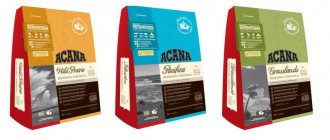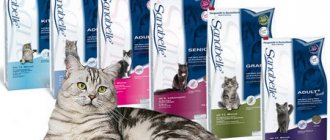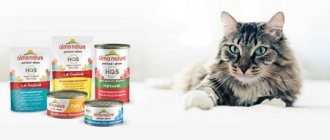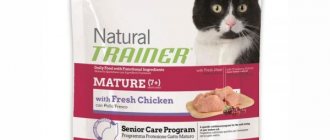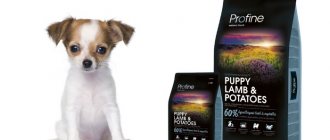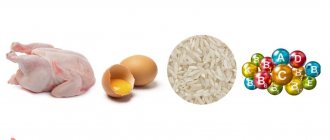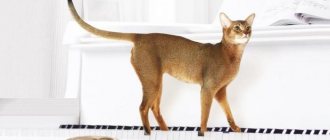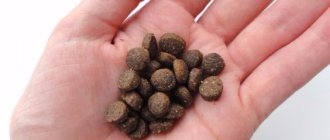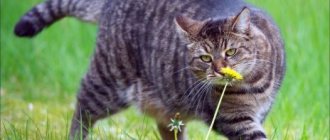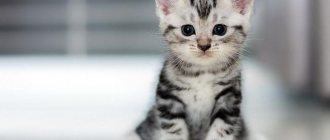Product composition
The manufacturer of Dreamies vitamin complexes is Mars. The products are a complement to the daily diet, consisting of minerals, vitamins and amino acids.
Crispy pillows for cats “Dreams” are an economy class product. They are sold in supermarkets and pet stores. The manufacturer produces different types of products, with different tastes. The food is packaged in small bags of 30, 60 and 140 g. The packaging contains information about the maximum allowable amount per day - 15 pads. These recommendations must be followed so as not to harm the animal’s body. Crispy treats for cats have a delicate filling inside. Dreamies products are low in calories, containing 2 kcal per puff.
Treats with different flavors are intended for pets over one year of age. Dreamies contains essential nutrients for cats. Main components:
Taurine can be found in this product.
- meat and meat by-products;
- fish and fish derivatives;
- seafood;
- protein extracts of plant origin;
- fats and oils;
- cereals;
- vegetable by-products;
- vitamins A, B1, B2, B6, D3, E;
- minerals;
- taurine;
- amino acids;
- methionine
Why give treats?
What if there is a need to spend money on treats and give them to the cat? Eat. The treat will be useful in the following cases:
- when you want to pamper your cat and reward him with new taste sensations;
- for additional motivation of the cat to start hunting for a tasty treat, turning it into a real game with a pleasant prize in the final. This will entertain both the cat and the owner;
- if you need to divert the cat's attention from the aromas of tasty but harmful human food, which cannot be fed to your pet, by offering her a treat in the form of a healthy alternative;
- if the owner is absent, but is worried that his cat will miss him;
- for the purpose of praising patience and good behavior (especially important when carrying out procedures that are unpleasant for the cat, such as trimming claws with a nail clipper, cleaning ears, etc.).
Varieties
Dreams pads contain the following main components:
- chicken;
- beef;
- duck;
- cheese;
- salmon.
The features of the treats are described in the table:
| Main Ingredient | Peculiarities |
| Chicken | Cats like it |
| Quickly addictive | |
| Beef | Low calorie product |
| Store for no more than 4 weeks after opening the bag. | |
| Duck | Pets like the taste of duck |
| The food contains wheat, which can cause allergies. | |
| Cheese | Adaptation of taste to animal preferences |
| Dosage must be strictly adhered to | |
| Salmon | Low calorie product |
| The pet quickly gets used to the food |
The funny mouse serves as a toy and a nutritious addition to the diet.
The manufacturer has developed and produces a “Mouse” toy for cats, inside of which there is a treat. This product tastes like chicken. After your pet eats this treat, the toy can be filled with another treat. The cat’s body will receive the necessary useful components, and the cat will have plenty of play and will be in a great mood.
Dreamies treat for cats
A year of expensive treatment, the result is disappointing. Why did you buy it, how did you get hooked on it, how did you wean it off. Analyzes.
I really don’t like writing about sores: neither my own nor others’.
But very often I see photographs of pets with this “delicacy” in the background. And there are plenty of positive reviews here...
And I understand that it is useless to explain something to people. I just hope that my story will make someone reconsider their attitude towards such encouragement. And don’t be so indifferent to the life of an innocent animal, which must pay with its health for the stupidity of its owners!
We are responsible for those we have tamed.
Exactly. When choosing a cat, especially a purebred one, as a pet, you must keep in mind that he will be demanding in terms of nutrition. Not in the sense of capricious, but in terms of health.
As is known, the most susceptible to urolithiasis are:
cats (male), purebred cats, castrated cats, cats that eat cheap dry food.
Of course, there are exceptions. About 20 years ago, everyone bought kiteket (whiskas was more expensive, like “elite”, but ours didn’t eat it). There was little money, we ourselves also ate pasta, sausages... And... somehow no one thought about proper nutrition! And when did Rolltons, chips, and Snickers come to us? American, delicious! Harmful. We didn’t think much about ourselves...
Our cats ate kiteket, ate from the table, drank milk, did not eat fish (the cat has allergies - his ears itched, so they did not give it to anyone). We lived for 18-22 years, we went to the veterinarian once every five years, there were practically no problems.
What does this mean?
Nothing. I was just lucky that my body was more resilient.
And then we took a black cat. British.
The food was immediately given as recommended by the breeder. Proplan.
There was always plenty of water in the house. Bowls, mugs are placed in all corners...
During the first years, he didn’t ask for or want anything other than his own food.
Then he began to sometimes beg for meat, exclusively chicken breast. He didn’t recognize anything else. Fitness cat
I could drink milk... The volume of a hole in a saucer. A tablespoon maximum.
There were no problems.
How did you buy it for the first time?
In a small town, a bright bag attracted attention. Bought once, twice...
I repeat, there are no visible health problems.
Different tastes
Eat with cheese, chicken, beef, fish. The latter, in a blue bag, caused the greatest delight!
The composition is indicated on the packaging. Scary? I don’t know... There are even vitamins...
with cheese with chicken with beef with salmon
How they gave it
Every morning began with “scratching” the head and purring. Like get up and go to the kitchen.
As requested! As requested! Whole performances!
Sometimes they gave me a piece. Sometimes they added a small mound to the main food. There was always many times more of it, normal food, in the bowl.
By the way, at the beginning of this whole story I tried to give these pads to street cats. They’ll eat the beef (it was good!), but these guys sniff it and leave.
The first bells
The toilet has small pebbles, so the color of the urine is not visible... We noticed that I began to sit for a long time.
We decided to observe and removed the filler. Pink urine. Into a syringe and for analysis.
Analyzes
Urolithiasis. Confirmed.
There are stones. Currently a year of treatment. How much did it grow before?
Ultrasound, observation, injections. Special food. Treatment. Because there was a possibility that it might “dissolve.” Surgery is in the future. And so it happened. The cat underwent the operation very hard and with complications. Now in the process of recovery and under observation. We are very worried. This is a lot of stress for both him and us...
VETERINARIANS ARE STRICTLY AGAINST THESE PADS! Not a little, not as encouragement, not at all!
It was not possible to wean off immediately
You can't imagine how much he demanded them!!!
At first they gave 1 per day, then every 2, less often. Then special food arrived, which he didn’t want to eat at all. They put one in it so that it would become saturated with the smell. Then they stopped. Finally, I got used to the food. They began to treat and pamper us with urinari pate. He, plows, fell in love with him. Now I'm begging for a new treat! The pads were conveniently forgotten.
But it would be better to remove it right away! Not one, not at all, ever!
So the result is a difficult operation.
“But he asks so, so he asks!” — I read reviews and comments. That's what we said.
Surgery, IVs, injections, suspensions, infusion of medications through a syringe, smelly pills - did the cat ask for all this too?
As one wrote to me here: “You overfed and spoiled the cat there. And I recommend it to everyone!”
I was bombed.
It was, to say the least, tactless and illogical... They overfed, i.e. They also gave it, only our cat is 5 years old, and hers is still small? Anyway.
I just believe that those who have their own heads on their shoulders will draw the right conclusions.
These pads aren't that cheap! Why not buy a treat instead that won't harm the animal?
What kind of “pampering” is this that ends in the suffering of the animal?
The topic is not very pleasant for me, because... associated with great experiences.
Before the operation, the cat was cheerful, played, purred and did not show that he was in pain. And he couldn’t help but be!
The cat turned out to be highly predisposed to urticaria, we ruled out everything that could in any way provoke it. Although basically there is nothing special to blame except for these pads, perhaps water (I liked to drink from the tap once, but for a long time only filtered, like ourselves). And a separate topic is food... The combination of factors has not been canceled.
I don’t recommend it to anyone if your pet’s health is truly important to you!
Flaws
The downside is that treats cannot be given to kittens. When feeding adult pets, do not exceed the dosage depending on body weight, otherwise it may cause harm to the animal's body. Another disadvantage is the lack of narrowly targeted formulas, taking into account the physiological individual conditions of the cat: during pregnancy and lactation, for aging animals, castrated and sterilized cats.
There are no complexes with a therapeutic effect: general strengthening, to improve the condition of the coat and skin, urological - to prevent urolithiasis, etc. It is important that Dreams products can quickly become addictive. Many cat owners note in their reviews that their pets “go crazy” with Dreamies. Therefore, the composition contains flavor enhancers.
What is a cat treat?
A cat treat is a product that contains ingredients that are especially attractive to a small predator. Very often, dried fortified meat or fish is offered as such. But no matter how much you love to pamper your cat, you cannot constantly feed him ready-made treats. Their composition is calculated based on the condition that such goodies make up no more than ten percent of a pet’s daily diet.
Treats are given to the animal:
- to pamper him;
- to force you to hunt a little by making an impromptu “mouse” out of a tasty treat;
- as a reward for patient behavior during unpleasant hygiene procedures - bathing, ear cleaning, nail trimming;
- as a stimulus for training;
- leaving home so that the pet is not so bored.
When purchasing “goodies” for your cat, you need to carefully study their composition and purpose. Most treats are only suitable for adult and healthy animals and are not recommended for kittens or cats during lactation and pregnancy. Only cats that are constantly on natural feeding, which is poor in minerals and other beneficial substances, may need vitamin treats.
Types of treats
The modern market presents several types of treats, differing in form, composition and purpose:
- Neutral - suitable for cats of all ages (including kittens), they do not have any special nutritional value, they are attractive to animals due to the presence of sugars. Often produced in the form of biscuits, pillows, and gummies.
- Vitamin - contain a vitamin-mineral complex, so such treats can only be treated in doses. They are made in the form of large tablets in the shape of circles, hearts, and mice.
- Nutritious - having increased nutritional value, the packaging with such delicacies is marked snack (light snack). They are usually made from natural products and can be used as food for the animal. The shape can be in the form of small sausages or pieces of meat.
- Preventative - such treats, in addition to the taste that is attractive to cats, have components that affect the health of the pet. It is advisable to use them on the recommendation of a veterinarian. Available in the form of pastes, pads, tablets.
Treats can be wet (pastes, jellies, purees, cream soup) or hard (tablets and pads of various types, dried meat or fish, sausages).
Photo gallery: delicacy release forms
Treats in the form of tablets can come in a variety of shapes, but the bright color attracts owners, not their pets
Wet treats are packaged in pouches or tubes and usually have a screw cap
Dried pieces of meat - a natural treat for cats
Dry sausages contain a large percentage of natural meat, but may also include other components
How to choose a treat for your cat
For those owners who want to purchase treats with the goal of simply pampering their pet and rewarding it for exemplary behavior, it is recommended to choose soft treats for cats - gummies, jellies, balls, baked fillets.
For a cat that has a strong jaw or needs additional prevention of plaque formation, it is better to purchase dry or semi-dry treats - biscuits, sausages.
It is recommended to give a cat of any age group any of the vitamin treats, provided that it is correctly selected in accordance with the age of the pet and the characteristics of its lifestyle. If it is difficult for the owner to do this on his own, it is better to seek help from a veterinarian.
For a fluffy animal, a treat is suitable that prevents excess fur from accumulating into lumps - pastes, etc.
A veterinarian should prescribe preventive treats.
